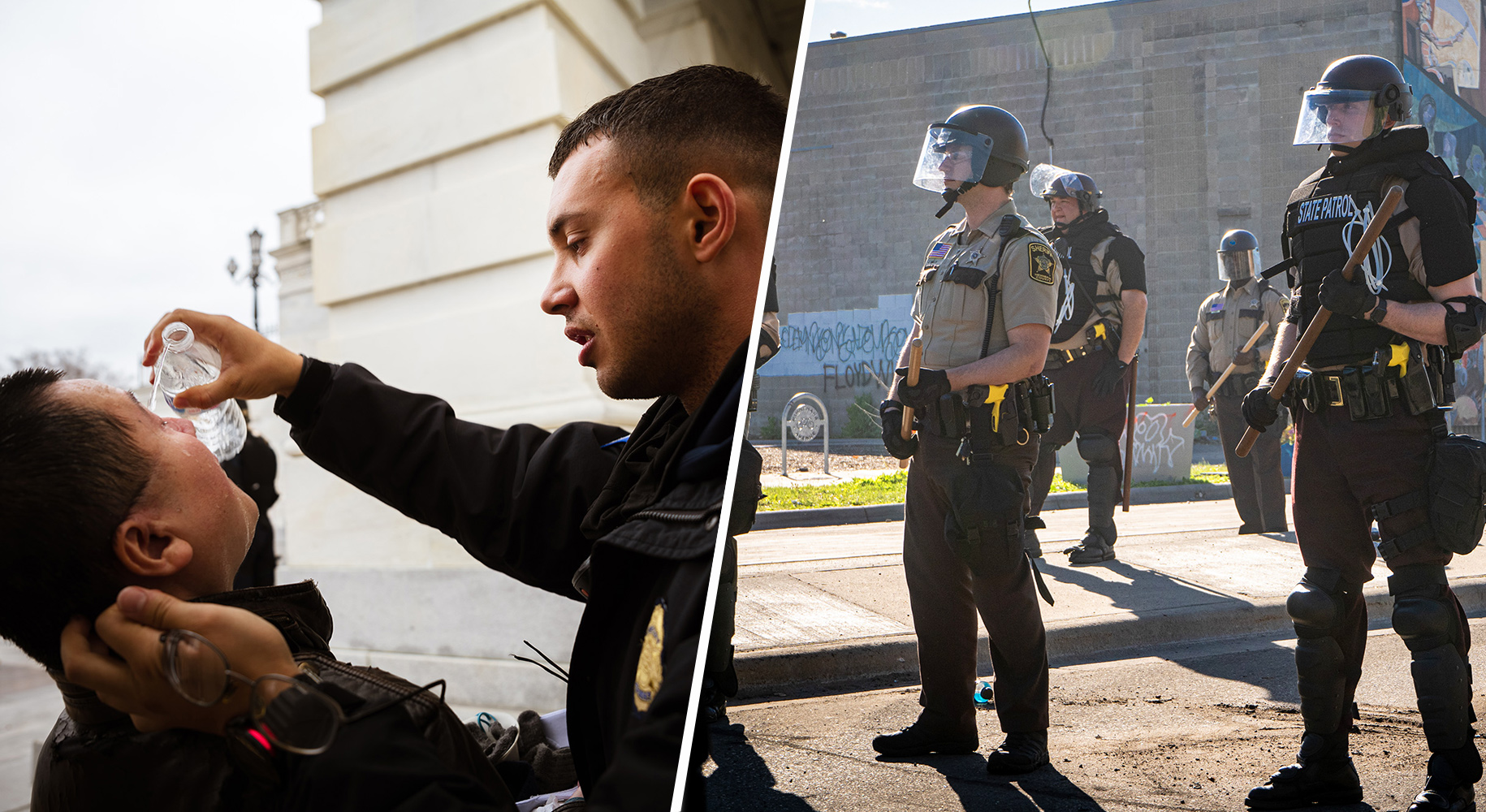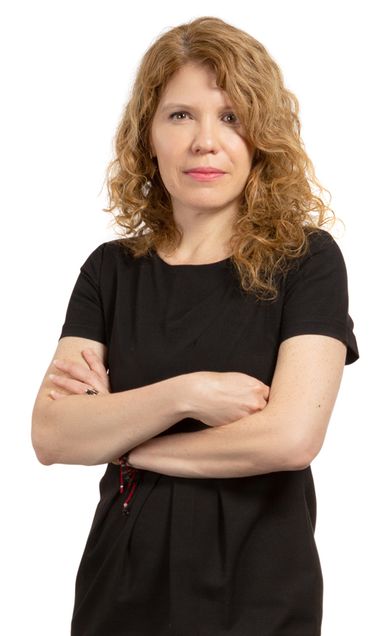Professor Examines Government Response to Protests
Professor Karen Pita Loor works to prohibit blanket curfews restricting First Amendment activity. Her research also looks at the selective use of excessive force in protest policing.

Photo at left by Jon Cherry via Getty Images; at right by munshots via Unsplash
Government Response to Protests
Professor Karen Pita Loor is working with a California vice mayor to prohibit blanket curfews restricting First Amendment activity. Her work also looks at the selective use of excessive force in protest policing.
Last summer, Boston University School of Law Professor Karen Pita Loor received an email out of the blue from Sophie Hahn, the vice mayor of Berkeley, California, who wanted to learn more about how to protect people’s First Amendment rights during protests.

Hahn’s council had voted in June to ratify and extend a curfew enacted by the Berkeley city manager during protests that erupted in response to the killing of George Floyd by a Minneapolis police officer. Hahn was uncomfortable with the blanket curfew, which prevented anyone in the city from leaving their homes at night with limited exceptions, and was working on legislation to ensure future curfews would be based on more clearly articulated standards.
“You couldn’t drive, you couldn’t walk, you couldn’t ride your bike,” she explains. “The curfew was for the whole night, in every part of town, and for all activities, including peaceful protest.”
Although she was part of the majority who voted to extend the curfew, Hahn felt she hadn’t been able to make an informed decision about whether the restrictions were necessary or could have been narrowed in scope, so she began researching laws around protests and curfews. Almost immediately, she and her team found Loor’s 2019 Seattle University Law Review article, “When Protest Is the Disaster: Constitutional Implications of State and Local Emergency Power,” which argues in favor of greater scrutiny of state and local emergency powers—including curfews—that curtail First Amendment rights.
For the article, Loor talked to emergency management officials in five states—Virginia, Maryland, Missouri, North Dakota, and North Carolina. Ultimately, she concluded that local and state officials should face greater scrutiny when they deploy emergency powers. Loor suggests that scrutiny could come from courts in the form of heightened review or from special councils that could be created to guide decisions in this area. In light of last week’s assault on the United States Capitol by Trump supporters, Loor’s work, which includes a forthcoming article on excessive force during protest policing, is even more relevant. As the events of Jan. 6 made clear, the real problem in the United States is not just the excessive use of police force but the selective use of such force, generally against people of color. Law enforcement immediately faced criticism for their failure to prevent a mob of mostly white men from entering the Capitol building in one of the worst security breaches in US history.
“This differential policing of Black and brown activists is nothing new,” Loor says, noting that police treatment of far-right white activists, including groups like the Proud Boys—whom Trump refused to denounce during a 2020 presidential debate—and heavily armed militiamen, during pro-police and pro-“patriot” protests has been amicable, and even at times collaborative, in stark contrast to their treatment of racial justice protesters.
We have to be more skeptical when what law enforcement is claiming is the source of the emergency is actually First Amendment protest activity.
For Hahn’s purposes in Berkeley, Loor’s work on protests was perfectly on point.
“When I read [the 2019 article], my heart leapt,” Hahn says. “In a way, I had been sort of reinventing her analysis on the fly when I was at the council meeting. I was asking the questions but I didn’t have the legal research or theoretical framework. That was the great gift of Professor Loor’s work.”
After testimony by experts including Loor, the Berkeley city council voted unanimously to move forward with Hahn’s proposed legislation, which would require that curfews be narrowly tailored and that less restrictive means be considered before enacting curfews, among other protections for protesters. Over the past several months, Hahn and Loor, along with members of Hahn’s staff and Loor’s research assistant Christiana Prater-Lee (’22), have worked together on how to codify such changes in the city’s municipal code. Once final language comes back from the city’s legal department, the city council will vote on whether to approve the new language.
Loor says the efforts of Hahn and her fellow council members are “absolutely the right thing to do.”
“We have to be more skeptical when what law enforcement is claiming is the source of the emergency is actually First Amendment protest activity,” Loor says.
Protest law and protest policing are relatively new areas of inquiry for Loor, a former public defender who spent several years supervising students in BU Law’s Defender Clinic and now serves as BU Law’s associate dean for experiential education. Loor says she first became interested in writing about the topic after seeing the response to protests in Ferguson, Missouri, in the wake of Michael Brown’s 2014 killing by police.
“I didn’t understand what it was that gave law enforcement the ability to react in such a militarized way,” she recalls.
After Floyd’s killing last year, Loor says she was “horrified like everybody else.” She also felt she had some special insight into the police response to the protests that followed because of her research. Journalists agreed: Loor provided expert commentary for national journalists covering curfews, as well as local journalists in Columbus, Ohio, and San Diego, among other places.
“I felt like I had an insider’s view into what was going on,” she explains. “I saw my article come to life across jurisdictions.”
Last week, she saw her work come to life again, this time in the—at least initially—notably lackluster response of law enforcement to pro-Trump rioters who stormed the Capitol as Congress was meeting to certify the election of President-Elect Joe Biden and Vice President-Elect Kamala Harris.
Loor’s forthcoming article, to be published in the Southern California Law Review, examines the police response to the George Floyd protests last summer and the ensuing violations of protesters’ First and Fourth Amendment rights. It describes some of the violent police response to those protestors, including an officer telling a protestor who was having an asthma attack inside a police van: “if you wanted to breathe, you should have stayed home tonight,” and a protestor handcuffed to a bridge for several hours while bleeding. Meanwhile, in DC on Jan. 6, one widely circulated video captured a police officer leading a Trump supporter by hand down the Capitol steps.
Loor says the disproportionately violent or lenient responses to protests on one hand and armed insurrections on the other are proof that state and federal governments should apply more scrutiny to police practices.
“As has been proven time and time again, law enforcement responses are often based on the racial identity of activists and the nature of their message instead of on actual signs of danger,” Loor says. “Police cannot be trusted to make these decisions and their discretion must be reined in.”
